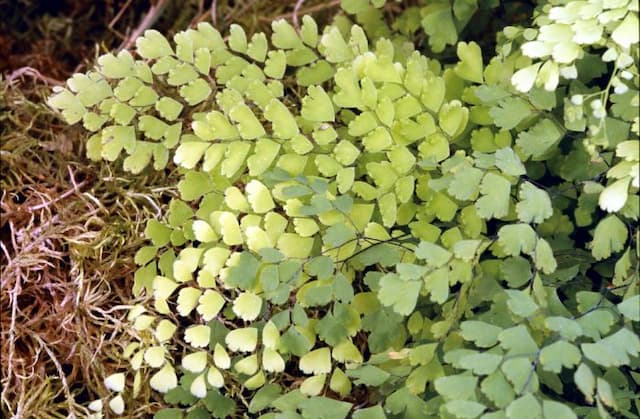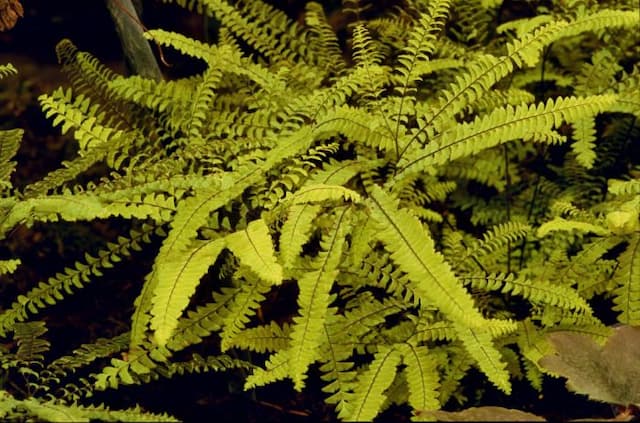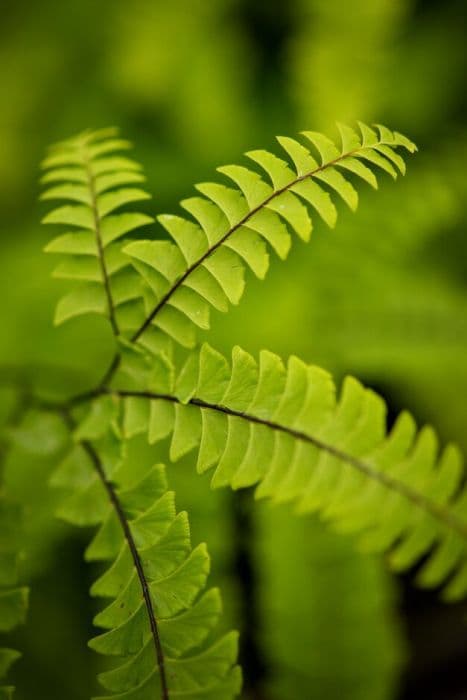Western maidenhair fern Adiantum aleuticum

ABOUT
The plant known as the Western maidenhair fern is characterized by its graceful and delicate appearance. It sports arching fronds that give it a feathery look, creating a sense of lightness and elegance in the landscape. The fronds are comprised of small, fan-shaped leaflets which are arranged in a pattern resembling a ladder. Each leaflet has smooth edges and displays a vibrant green hue that can brighten shady areas. The stalks of the fronds possess a distinctive dark color, often resembling a shiny black or deep purple, adding to the plant's ornamental appeal. These striking black stalks stand out vividly against the lush green of the leaflets. The overall growth habit of the Western maidenhair fern is one of graceful spreading, resulting in a plant that looks airy and is often used to add texture and visual interest to gardens and natural settings.
About this plant
 Names
NamesFamily
Pteridaceae
Synonyms
Western Maidenhair Fern, Aleutian Maidenhair, Five-fingered Fern, American Maidenhair Fern, Serpent Fern, Northern Maidenhair Fern, Aleutian Maidenhair Fern
Common names
Adiantum pedatum subsp. aleuticum, Adiantum pedatum var. aleuticum.
 Toxicity
ToxicityTo humans
Western maidenhair fern (Adiantum aleuticum) is generally considered non-toxic to humans. There are no well-documented cases of poisoning from ingesting this fern, and it does not contain any known toxic compounds that would pose a risk to human health. Consequently, there should be no toxic symptoms or consequences from ingesting parts of the Western maidenhair fern.
To pets
Western maidenhair fern (Adiantum aleuticum) is also non-toxic to pets such as cats and dogs. It is not associated with any significant toxic effects, and ingestion should not result in poisoning symptoms in pets. Consequently, consuming this fern should not lead to any adverse health consequences for pets.
 Characteristics
CharacteristicsLife cycle
Perennials
Foliage type
Deciduous
Color of leaves
Green
Height
1-2 feet (30-60 cm)
Spread
1-2 feet (30-60 cm)
Plant type
Fern
Hardiness zones
3-8
Native area
North America
Benefits
 General Benefits
General Benefits- Aesthetic Appeal: Adiantum aleuticum, commonly known as the Western maidenhair fern, offers soft, delicate fronds that create a visually pleasing, feathery texture in gardens and indoor settings.
- Shade Tolerance: This fern is well-adapted to shade, making it ideal for planting in woodland gardens or shaded areas where other plants might not thrive.
- Humidity Loving: As a fern, the Western maidenhair appreciates humid environments and can enhance the moisture level of its immediate surroundings.
- Erosion Control: The creeping rhizomes of the Western maidenhair help stabilize soil, making it valuable for erosion control in suitable landscapes.
- Cooling Effect: Like other plants, it contributes to a cooling effect in gardens and environments due to transpiration and shade it provides.
- Habitat Enhancement: This fern provides habitat for various species of insects and small wildlife, increasing biodiversity in its native ecosystem.
- Low Maintenance: Once established, it requires minimal care, making it a suitable choice for low-maintenance landscapes and gardens.
- Adaptability: Adiantum aleuticum is adaptable to a range of soil types, although it prefers well-draining, fertile substrates.
- Non-Invasive: Unlike some fern species, the Western maidenhair is non-invasive, meaning it will not overrun areas and outcompete other vegetation.
- Seasonal Interest: The fronds of the Western maidenhair change throughout the seasons, adding to the year-round interest in a garden or landscape setting.
 Medical Properties
Medical PropertiesThis plant is not used for medical purposes.
 Air-purifying Qualities
Air-purifying QualitiesThis plant is not specifically known for air purifying qualities.
 Other Uses
Other Uses```html
- Biodegradable containers: Adiantum aleuticum, commonly known as western maidenhair fern, can be used to create biodegradable plant containers, providing a sustainable alternative to plastic pots.
- Floral arrangements: The delicate fronds of the western maidenhair fern are often used in floral arrangements to add texture and a gentle, feathery grace.
- Shade garden aesthetics: Due to their preference for shaded areas, these ferns are ideal for enhancing the visual appeal of shade gardens, grottos, and woodland settings.
- Erosion control: Western maidenhair ferns can be planted on slopes and banks to help reduce soil erosion thanks to their spreading rhizomes.
- Indoor terrariums: The small size and humidity preference make these ferns perfect inhabitants for terrariums and enclosed garden spaces.
- Nature-inspired art: Artists often use the intricate leaf patterns of the fern for botanical illustrations, nature prints, and designs.
- Photography subject: With their intricate frond structure, western maidenhair ferns are a popular subject for photographers specializing in macro and plant photography.
- Crafting natural dyes: The fronds can potentially be used in the crafting of natural dyes, although specific dye recipes involving Adiantum aleuticum are less documented.
- Education and study: These ferns can be used in educational settings to teach about plant biology, life cycles, and the importance of preserving biodiversity.
- Living mulch: When planted densely, western maidenhair ferns can act as a living mulch, helping to retain soil moisture and suppress weed growth.
Interesting Facts
 Feng Shui
Feng ShuiThe Western Maidenhair Fern is not used in Feng Shui practice.
 Zodiac Sign Compitability
Zodiac Sign CompitabilityThe Western Maidenhair Fern is not used in astrology practice.
 Plant Symbolism
Plant Symbolism- Delicacy: Adiantum aleuticum, commonly known as the Western Maidenhair Fern, has fine, delicate fronds that can symbolize a sensitive and gentle nature.
- Secret Bond of Love: Maidenhair Ferns are sometimes associated with love and secrecy, as their intricate pattern can be seen as hiding secrets between lovers.
- Purification: Ferns in general are often related to purification because they grow in moist environments that promote a sense of freshness and cleansing.
- Eternal Youth: The Maidenhair Fern's association with lushness and growth can symbolize the eternal renewal of youth.
- Health: Historically, the Maidenhair Fern has been used in traditional medicine. Because of this, it can symbolize overall health and well-being.
 Water
WaterThe Western maidenhair fern should be watered regularly to maintain consistently moist soil without it becoming soggy. Typically, this means watering every 7 to 10 days, but you should adjust according to the moisture level of the soil; it should not dry out completely. Depending on the size of the pot and the environmental conditions, you might need to provide about 16 to 24 ounces of water per watering session. However, during the growing season, in spring and summer, the plant may require more frequent watering, while in the cooler fall and winter months, water less frequently.
 Light
LightWestern maidenhair fern thrives best in filtered, indirect light, avoiding direct sunlight that can scorch its delicate fronds. It does particularly well in north-facing or east-facing windows, where it can receive gentle morning light and shaded afternoon light, or under a canopy of taller plants that provide dappled shade.
 Temperature
TemperatureThe Western maidenhair fern prefers moderate temperatures, typically thriving in a range between 60 to 75 degrees Fahrenheit. It can endure temperatures as low as 50 degrees Fahrenheit but should not be subjected to cold drafts or temperatures below this range, as it may be detrimental to the plant's health. Ideal conditions for this fern include a consistently warm, humid environment without extreme temperature fluctuations.
 Pruning
PruningPruning the Western maidenhair fern is generally conducted to remove any brown or damaged fronds, keeping the plant healthy and aesthetically pleasing. It's best to prune at the end of winter or the start of spring before new growth begins. Typically, this plant doesn't require frequent pruning; once per year should suffice to tidy up the appearance and encourage new, fresh growth.
 Cleaning
CleaningAs needed
 Soil
SoilThe Western maidenhair fern thrives in a rich, loose, and well-draining soil mix with a slightly acidic to neutral pH of 6.0 to 7.0. A recommended soil mixture can be made by combining equal parts of peat, loam, and perlite to ensure good aeration and moisture retention.
 Repotting
RepottingWestern maidenhair ferns generally require repotting every 2 to 3 years to replenish the soil and give the roots ample room to grow. It's best to repot in the spring just before new growth begins.
 Humidity & Misting
Humidity & MistingWestern maidenhair fern prefers high humidity levels, ideally between 60% to 80%. Maintaining this humidity can be crucial for the health of the plant, particularly when grown indoors.
 Suitable locations
Suitable locationsIndoor
Provide bright, indirect light and high humidity.
Outdoor
Place in shaded area with moist soil and shelter.
Hardiness zone
3-8 USDA
 Life cycle
Life cycleThe western maidenhair fern, Adiantum aleuticum, begins its life cycle as a spore, which, upon finding a suitable moist and shaded environment, germinates into a prothallus, or gametophyte stage. This small, heart-shaped gametophyte houses the reproductive organs that produce sperm and eggs. When conditions are optimal, typically involving water for sperm motility, fertilization occurs, leading to the formation of a zygote which grows into the sporophyte—the familiar fern plant. This sporophyte emerges as a fiddlehead, unfurling its fronds as it matures. As the plant reaches maturity, it develops sori on the undersides of its fronds, which are clusters of sporangia that produce and release new spores, thus completing the life cycle. The fronds of western maidenhair fern are delicate and fan-shaped, with dark, wiry stems, often growing in clumps and thriving in the cool, damp environments of forest floors.
 Propogation
PropogationPropogation time
Spring-Early Summer
The most popular method of propagation for the Western Maidenhair Fern, Adiantum aleuticum, is through division of the rhizomes. This is often done in the spring when the plant is actively growing. The fern should be gently lifted from the soil and the clump carefully separated into smaller pieces, ensuring each section has a portion of the rhizome and fronds. These divisions can then be replanted into moist, well-draining soil at the same depth they were originally growing. It's important not to bury the crown of the plant to prevent rot. The divisions should be kept in a shaded area and watered regularly until they are established.




